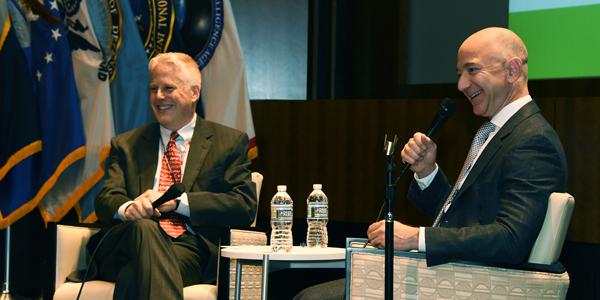Cyber + Kinetic Forces = Intensified Threats
While stopping weapons of mass destruction and cyber attacks are high security priorities, the kinetic effects from cyber forces are a looming threat today. Malevolent uses for artificial intelligence combined with autonomous systems provide frightening new levels of capabilities to potential adversaries, and the U.S. Defense Department and the intelligence community are being called upon to address them with extraordinary vigor.
The National Security Strategy (NSS) and National Defense Strategy (NDS), both relatively brief documents, not only outline the threats from these emerging technologies but also the steps organizations must take to protect and defend the United States, the defense industrial base and the national security base from them. For example, the NDS states: “During conflict, attacks against our critical defense, government and economic infrastructure must be anticipated.”
Lewis Shepherd says this is the first time artificial intelligence (AI) is dealt with at these leadership levels and in substantive national security strategic and doctrinal ways. Currently an executive consultant on advanced technologies at Deloitte, Shepherd formerly worked for the Defense Intelligence Agency as well as several Silicon Valley companies.
“We’ve studied the issue [of AI] in several important reports over the past five years, but it’s the first time that it's called out, really rising to the strategic level for national security to take action,” Shepherd states. Under the call for modernizing key capabilities, the NDS calls on the Defense Department to invest broadly in the military application of autonomy, AI and machine learning.
Increasing attention to AI and autonomy is important to understanding the role they play for U.S. adversaries as well as how the United States could employ them better, faster and more effectively. The latter would enable the country to leapfrog some of the enduring challenges it faces as a large, open society that's democratically governed, he explains.
New technical capabilities also will be beneficial to the intelligence community for collection and analysis of information. “That's where AI capabilities are already beginning to add new strength. It kicks our capabilities up a notch in range and reach and tactical employment dexterity. It can be very, very powerful," he says.
Kicking up capabilities is especially important considering what Shepherd sees as an impending threat today: a hybrid of the kinetic effects from cyber forces. One example of this type of attack was Stuxnet. “But increasingly we see the ability to do that from adversaries in other domains like space and in other military domains. That’s the problem.
“If we think about drone warfare and unmanned aerial vehicles and unmanned autonomous systems at sea, that’s the translation of cyber effects into a kinetic package. No human is involved in many of those loops,” Shepherd says.
Some of the United States’ adversaries’ kinetic delivery systems already are becoming semi-autonomous, he adds. “So we have to study and understand them as cyber processes because that’s how they work, but they absolutely are translated in real and kinetic force," he explains.
The NSS and NDS also encourage new and more open collaboration between government agencies and industry, including an updated definition of the industrial base for defense and intelligence. A prime example in the intelligence community (IC) is the Intelligence Advanced Research Projects Activity (IARPA) prize challenges, a practice that is a staple approach in Silicon Valley and the technology industry to promote innovation, new ideas, new capabilities and new startups, Shepherd relates.
“We've had pinprick efforts from most of the IC agencies to foster and nurture startups and innovative participation in their efforts. But this is the first year that we've actually had those new nontraditional approaches explicitly called for, advocated and promoted at the level of the NSS and NDS. So there is absolutely vocal, energetic and funded support at the senior-most level of the government and the national security establishment to make sure the nation takes advantage of the energetic creativity that exists in the commercial world," he declares.
Both of the strategies as well as the hot topics of AI and autonomy will be discussed in depth at AFCEA’s Spring Intelligence Symposium. The classified (TS/SI/TK-NOFORN) event takes place April 18-19 at the NGA Campus East in Springfield, Virginia.
Shepherd sees the symposium as an important venue for building trust among the IC, Defense Department and industry. “Professionals in industry can sit side-by-side with truly top-level IC and Defense Department technologists, decision makers and policy makers and actually explore these kinds of challenges directly face-to-face in a really open and collaborative way,” he states. Because the forum is classified, participants are willing to share and explore new directions and be frank, which builds trust,” he states.
“On a broader level, there’s never been more of a need than now for collaboration and real hand-in-hand partnerships between the government and industry, particularly industry defined in a more inclusive way,” he emphasizes. In addition to traditional contractors and integrators, a new generation of technologists are working individually, on contracts or as part of efforts with data systems, programming languages and platforms that staff at government labs and spaces sometimes cannot access, Shepherd explains.
The timing of this year’s symposium also is key. “The IC is off and running at 100 miles an hour to execute on these two new strategies. … We’ve got a desire to explore a kind of massive mindset change from 15 years of prioritizing the counterterrorism threat to now one of understanding the new degree of threat from peer adversaries.
“This is really an extraordinary moment. It’s an inflection point with the [intelligence] community and all of its moving parts dealing with a moment of change. This symposium offers a great opportunity to influence the steps we all take out of it,” he states.
Cleared defense, intelligence and industry personnel can register for AFCEA’s Spring Intelligence Symposium online.





Comments